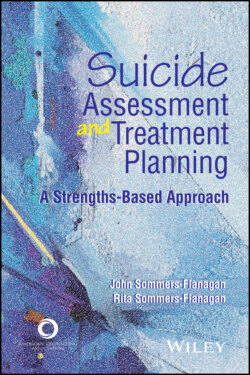Читать книгу Suicide Assessment and Treatment Planning - John Sommers-Flanagan - Страница 25
Staying Focused When Strong Emotions Rise Up
ОглавлениеAs a Catholic, Mateo had deep moral values and an especially strong belief that suicide was morally wrong. As a graduate student in counseling, Mateo was learning about the need to bracket his values and not impose them on his clients. In his second year of training, Mateo worked with two clients who talked a lot about suicide. Whenever the word suicide came up in counseling, Mateo felt himself flinch inside. He had an impulse to plead with these clients to focus on God’s love as a solution to their suicidal crises. Mateo began questioning whether he could contain his moral judgments about suicide; he also began questioning whether he could continue in his training to become a professional counselor.
Mateo decided to discuss the feelings he was having with his supervisor. Mateo’s supervisor listened and helped Mateo explore his feelings. Later they brainstormed and problem-solved different ways Mateo could become better at monitoring and bracketing his moral judgments. In the end, Mateo and his supervisor identified four self-statements Mateo could use to compartmentalize or bracket his moral reactions:
1 “I know the research and clinical guidelines say that I can more effectively prevent suicide if I accept my clients’ suicidal ideation and remain nonjudgmental” (Jobes, 2016).
2 “I know that people who are feeling suicidal are already feeling shame; therefore, if I shame them in any way, I could increase their misery or sense of powerlessness.”
3 “I want to prevent suicide for religious and professional reasons. My best chance at preventing suicide involves using evidence-based assessment and treatment strategies.”
4 “When I feel triggered and judgmental, I will refocus my efforts on using nondirective paraphrases, reflections of feeling, open questions, and other motivational interviewing skills” (W. R. Miller & Rollnick, 2013).
Kocet and Herlihy (2014) offered a five-step counselor values-based conflict model to aid students and clinicians in ethical bracketing. Using Mateo’s situation as an example, we walk you through the steps of the model.
1 Determine the nature of values-based conflict. Mateo’s conflict was both personal and professional. Mateo believed that suicide was a sin, but he also knew that suicide competencies required him to listen nonjudgmentally as his clients talked about suicide.
2 Explore core issues and potential barriers to providing an appropriate standard of care. When his clients talked about suicide, Mateo was emotionally activated and felt impulses to confront clients with statements like “God loves you” and “Suicide is immoral” and “If you kill yourself, you’ll end up in hell.” These moralizing thoughts interfered with Mateo’s ability to have empathy for his clients.
3 Seek assistance/remediation for providing an appropriate standard of care. Mateo recognized his personal/professional conflict. He chose to meet with a supervisor he trusted to discuss the issues.
4 Determine and evaluate possible courses of action. Mateo and his supervisor agreed that Mateo could not avoid working with suicidality in counseling. They worked together to provide Mateo with a good rationale for using evidence-based (rather than religious-based) strategies for working with his clients. In addition, they identified internal cues that Mateo could use to alert himself to shift to using nondirective motivational interviewing skills.
5 Ensure that proposed actions promote client welfare. Mateo and his supervisor agreed to collaboratively and continuously monitor Mateo’s values-based judgments and behaviors during counseling sessions.
As illustrated in Mateo’s situation, personal values and attitudes have a complex and interactive relationship with self-care and ethical behaviors. Ethical bracketing is an important process for helping you juggle your values, attitudes, reactions, self-care, and ethical responsibilities. We return to ethical issues and counselor competence in Chapter 2 and beyond. For now, we turn to our strengths-based model for understanding and working with people who are suicidal.
